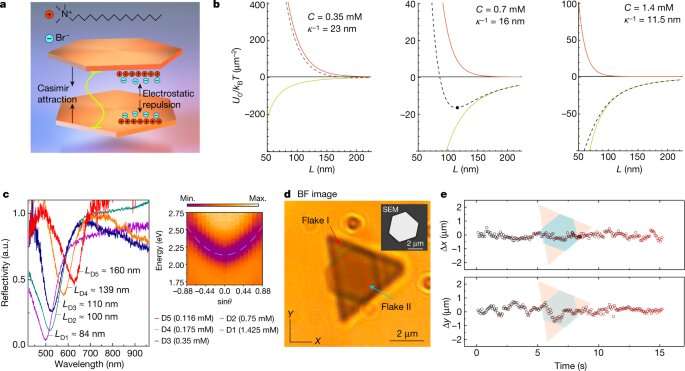Credit: DOI: 10.1038/s41586-021-03826-3
A team of researchers at Chalmers University of Technology has found a way to create self-assembling optical cavities that can reach a strong-coupling state that supports polariton formation. In their paper published in the journal Nature, the group describes how their optical cavities were made and possible uses for them. Johannes Feist with the Autonomous University of Madrid has published a News and Views piece on the work done by the team on this effort in the same journal issue.
Optical cavities are arrangements of mirrors that trap light. They are one of the major components of lasers. In this new effort, the researchers were working with tiny metal flakes that they believed could be used to create an optical cavity. To that end, they created an organic, ionic compound solution that held charged ions (both positive and negative). They then suspended tiny metal flakes in the solution, which coated the flakes with double layers of the ions, giving them a net positive charge—a situation that would normally lead to the flakes repelling one another completely. However, the flakes were also characterized by a Casimir force, which served to counterbalance the repelling forces. They arose due to random electron motion in the metal flakes. Together, the two forces resulted in the metal flakes self-assembling into mirrored pairs with a very small distance between them (approximately 100–200 nm), notably smaller than the diameter of the flakes. That space was found to trap light, which meant it was an optical cavity.
Optical cavities, such as those produced by the metal flakes, do not trap all the light in a system. They trap only certain frequencies, which allows them to form a standing wave. In such systems, the wavelength of the light that is trapped is determined by the length of the cavity. The researchers found that by manipulating the optical cavities, they could push them to support polariton formation. They note also that changing the distance between the metal flakes by altering the concentration of ions in the solution allowed for creating polaritons from different materials. They conclude that their approach could be used in a wide variety of applications, from optomechanical to polaritonic chemistry to nano-machinery.
More information: Battulga Munkhbat et al, Tunable self-assembled Casimir microcavities and polaritons, Nature (2021). DOI: 10.1038/s41586-021-03826-3
Johannes Feist, Hybrid light–matter states formed in self-assembling cavities, Nature (2021). DOI: 10.1038/d41586-021-02376-y
Journal information: Nature
© 2021 Science X Network
























